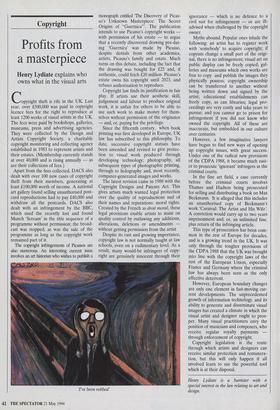Copyright
Profits from a masterpiece
Henry Lydiate explains who owns what in the visual arts
Copyright theft is rife in the UK. Last year, over £500,000 was paid in copyright licence fees for the right to reproduce at least 1200 works of visual artists in the UK. The fees were paid by bookshops, galleries, museums, press and advertising agencies. They were collected by the Design and Artists Copyright Society, a charitable copyright monitoring and collecting agency established in 1983 to represent artists and their estates. (Membership currently stands at over 40,000 and is rising annually — as are their collections of fees.)
Apart from the fees collected, DACS also dealt with over 100 new cases of copyright theft from their members, generating at least £100,000 worth of income. A national art gallery found selling unauthorised post- card reproductions had to pay £40,000 and withdraw all the postcards. DACS also dealt with an infringement by the BBC, which used the recently lost and found Munch 'Scream' in the title sequence of a programme without permission; the broad- cast was stopped, as was the sale of the programme as long as the copyright work remained part of it.
The copyright infringements of Picassos are also numerous. An interesting current issue involves an art historian who wishes to publish a monograph entitled The Discovery of Picas- so's Unknown Masterpiece: The Secret Origins of "Guernica". The publication intends to use Picasso's copyright works — with permission of his estate — to argue that a recently discovered drawing pre-dat- ing `Guernica' was made by Picasso, despite denials from other academics, artists, Picasso's family and estate. Much turns on this debate, including the fact that the drawing was bought for £25 and, if authentic, could fetch £20 million. Picasso's estate owns his copyright until 2023, and refuses authorisation to reproduce.
Copyright law finds its justification in fair play. If artists use their aesthetic skill, judgement and labour to produce original work, it is unfair for others to be able to use such work to make money for them- selves without permission of the originator — and, or, paying for the privilege.
Since the fifteenth century, when book printing was first developed in Europe, UK law has subscribed to this philosophy. To date, successive copyright statues have been amended and revised to give protec- tion to visual work produced through developing technology; photography, all subsequent types of photographic printing, through to holography and, most recently, computer-generated images and works.
The latest revision came in 1988 with the Copyright Designs and Patents Act. This gives artists much wanted legal protection over the quality of reproductions and of their names and reputations: moral rights. Created by the French as droit moral, these legal provisions enable artists to insist on quality control by outlawing any additions, alterations, deletions or amendments — without getting permission from the artist Despite its vast and growing importance, copyright law is not normally taught at law schools, even on a rudimentary level. As a result, many would-be infringers of copy- right are genuinely innocent through their 'I've been robbed' ignorance — which is no defence to a civil suit for infringement — or are ill- advised when challenged by the copyright owner.
Myths abound. Popular ones inlude the following: an artist has to register work with 'somebody' to acquire copyright; if copyists change a small part of the origi- nal, there is no infringement; visual art on public display can be freely copied; gal- leries and museums which own works are free to copy and publish the images they physically possess; copyright ownership can be transferred to another without being written down and signed by the artist; educational establishments can freely copy, as can libraries; legal pro- ceedings are very costly and take years to pursue; and you cannot go to prison for infringement if you did not know who owned the copyright. All of these are inaccurate, but embedded in our culture over centuries.
However, a few imaginative lawyers have begun to find new ways of opening up copyright issues, with great success. Under one of the radical new provisions of the CDPA 1988, it became much easi- er to prosecute 'ignorant' infringers in the criminal courts.
In the fine art field, a case currently before the criminal courts involves Thames and Hudson being prosecuted for selling and distributing a book on Max Beckmann. It is alleged that this includes an unauthorised copy of Beckmann's work 'Carnival: The Artist and His Wife'. A conviction would carry up to two years imprisonment and, or, an unlimited fine, plus return of the infringing article.
This type of prosecution has been com- mon in the rest of Europe for decades, and is a growing trend in the UK. It was only through the tougher provisions of the CDPA 1988 that the UK was brought into line with the copyright laws of the rest of the European Union, especially France and Germany where the criminal law has always been seen as the only effective deterrent.
However, European boundary changes are only one element in fast-moving cur- rent developments. The unprecedented growth of information technology, and its ability to generate and disseminate visual images has created a climate in which the visual artist and designer ought to pros- per. Many visual practitioners envy the position of musicians and composers, who receive regular royalty payments — through enforcement of copyright Copyright legislation is the route through which artists and designers can receive similar protection and remunera- tion, but this will only happen if all involved learn to use the powerful tool which is at their disposal.
Henry Lydiate is a barrister with a special interest in the law relating to art and design.




































































 Previous page
Previous page